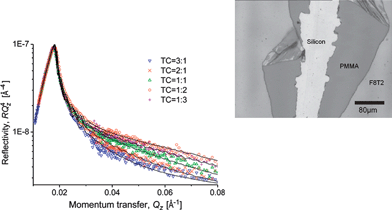Control of roughness at interfaces and the impact on charge mobility in all-polymer field-effect transistors
Abstract
The interfacial roughness at a buried dielectric–semiconductor interface in an all-

* Corresponding authors
a
Multidisciplinary Nanotechnology Centre, School of Engineering, Swansea University, Singleton Park, Swansea, UK
E-mail:
a.m.higgins@swansea.ac.uk
b Department of Physics and Astronomy, University of Sheffield, Hicks Building, Hounsfield Road, Sheffield, UK
c Cavendish Laboratory, University of Cambridge, J J Thompson Avenue, Cambridge, UK
d Laboratoire Léon Brillouin (CEA-CNRS), CEA Saclay, Gif-sur-Yvette Cedex, France
e ISIS Pulsed Neutron and Muon Source, Rutherford Appleton Laboratory, Chilton, Didcot, Oxfordshire, UK
The interfacial roughness at a buried dielectric–semiconductor interface in an all-

 Please wait while we load your content...
Something went wrong. Try again?
Please wait while we load your content...
Something went wrong. Try again?
S. S. Chang, A. B. Rodríguez, A. M. Higgins, C. Liu, M. Geoghegan, H. Sirringhaus, F. Cousin, R. M. Dalgleish and Y. Deng, Soft Matter, 2008, 4, 2220 DOI: 10.1039/B810278C
To request permission to reproduce material from this article, please go to the Copyright Clearance Center request page.
If you are an author contributing to an RSC publication, you do not need to request permission provided correct acknowledgement is given.
If you are the author of this article, you do not need to request permission to reproduce figures and diagrams provided correct acknowledgement is given. If you want to reproduce the whole article in a third-party publication (excluding your thesis/dissertation for which permission is not required) please go to the Copyright Clearance Center request page.
Read more about how to correctly acknowledge RSC content.
 Fetching data from CrossRef.
Fetching data from CrossRef.
This may take some time to load.
Loading related content
